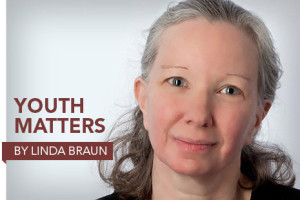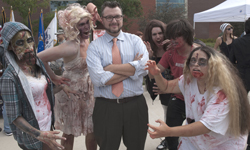
Librarians have always been major proponents of literacy campaigns, and now, for the past two years, many librarians have been participating in a new type of initiative: media literacy.
To help high school students differentiate between fact and fiction in today’s increasingly chaotic news—in which opinion-based cable news programs, blogs, and social media sites have proliferated—the American Library Association (ALA), in partnership with local library branches and a nonprofit media literacy organization, created News Know-How, a program that helps young adults become better, more savvy media consumers.
“The goal was to make librarians and the general public aware of media bias and to teach them how to read the news in a critical way, whether it’s a Facebook post, a newspaper article, or a radio report,” says Barbara Jones, director of ALA’s Office for Intellectual Freedom (OIF), who spearheaded the program.
In 2010, George Soros’s Open Society Foundations approached ALA about starting a media literacy initiative. Soon, OIF received a $750,000 grant from the foundation to develop and carry out the program for two years.
Jones says libraries were the right fit for the News Know-How program because they have the resources on hand—from knowledgeable librarians to extensive databases—to show students how to be their own watchdogs. “[Students and the public] need to be able to pick out bias and propaganda and check facts,” she says, “since facts and statistics are often mentioned in a way that makes them meaningless or misleading without context.”
The genesis
ALA introduced the first version of the full News Know-How program in the summer of 2012, following a trial run a year earlier during the Iowa Republican caucus. This version centered on the 2012 presidential election, with groups focusing on topics such as the media’s coverage of the candidates’ positions on health care and gun control.
OIF selected libraries in Chicago; Oak Park, Illinois; and eight branches throughout Iowa for the program.
The first year, OIF chose libraries with which it had a past relationship, “but we also wanted a variety of libraries,” Jones says. A rural state was especially ideal because she and her team wanted to see how the program would work in small towns and in multiple locations. The proximity to the Association’s Chicago headquarters made Iowa a good fit.
To round things out, Jones says, they also wanted a city library and a suburban library in the mix, so they selected Chicago and Oak Park, a nearby suburb.
After a successful initial run, Jones decided to open the program to libraries outside the Midwest. In 2013, the program was held in cities with highly concentrated populations. From more than 60 libraries that applied, OIF selected San Antonio (Tex.) Public Library and San José (Calif.) Public Library to implement News Know-How in its second year.
Partnerships
ALA partnered with the News Literacy Project (NLP), a nonprofit entering its sixth year teaching media literacy, to run the training sessions for students and librarians. NLP has worked with teachers on media literacy programs in New York; Washington, D.C.; Bethesda, Maryland; and Chicago.
Darragh Worland has been the New York program manager for NLP for almost three years and has led multiple media literacy programs for students in New York City. While NLP has worked with students as young as 11, most of its programs cater to high school students, and the vast majority of News Know-How participants have also been high schoolers.
Because of the NLP’s experience in working with teachers on media literacy programs throughout the country, Worland says NLP was asked to serve as lead trainers for ALA’s program.
The role of libraries
Erik Berman is a librarian at the Educational Park branch of the San José Public Library and was immediately interested when he heard about the program earlier this year.
“Media literacy ties in with information literacy, which is one of the most important things libraries can teach these days. I immediately recognized that a lot of the techniques that were most important in teaching media literacy also applied to information literacy,” says Berman, whose library offered the program June 17–28.
He says local students expressed a lot of interest in the program, but since there was room for only 16 students, he had to turn away more than 50 others. At the end of the two-week program, these teens—divided into groups of four—presented their findings at the library, and even some members of the city council attended.
Most of the groups did a straightforward presentation in which information was delivered through PowerPoint slides. But Berman says students took creative approaches, including one group that created an interactive game show about whether the information presented in the news was true or false.
In addition to groups’ findings on issues like media bias and news reliability, Berman thinks the News Know-How program was beneficial for getting teenagers engaged in the library. “The program is great for outreach,” he says. “One of the students involved in the program is now our teen volunteer coordinator, while several others are also volunteers.”
He says programs like News Know-How are essential for youth. “The role of libraries in the digital future is not just finding information, but how to know in a limited time if you can trust a source and know that the information you are receiving is credible,” Berman says. “There is a difference between the type of information you get from a blog or a Facebook post and the news you get from a credible reporter or from an [Associated Press] report. We have to go beyond what was once considered library work and move to where libraries are at the heart of a community, something more akin to community centers. In academic libraries, there is this idea of being a ‘third space’ and that’s just as important for public libraries.”
Students’ views
Students who expressed interest in the program were chosen after interviewing with librarians. In Iowa, 22 students participated in a centralized meeting, either in Cedar Rapids or Des Moines, based on where they lived. But even with the two sites, some students had to travel up to 200 miles to get to a training meeting.
Elise Westhoff of Dyersville, Iowa, found the sessions valuable. “The NLP staffers gave us a lot of information and direction and let us run with it,” she says. Westhoff was part of a team that focused on how accurately different forms of media quoted presidential candidates. She focused on blogs such as the Daily Beast and the Iowa Republican, while other team members reviewed newspapers and social media for accuracy. She says that all forms of media they analyzed were mostly accurate in quoting the candidates.
Megan Molloy, from Knoxville, Iowa, says she and her team fact-checked election coverage from the Des Moines Register, USA Today, and the Wall Street Journal, and their research continued through the presidential election. Molloy was drawn to the program because she was interested in becoming a journalist after college. But as she learned more about the demands of the profession, her interest waned.
“I would have to think very long and hard about it because I didn’t realize how much stress and pressure they [journalists] are under and how easy it is to have a minor slip-up,” she says.
Still, Molloy says the program was informative and made her a wiser news consumer. She has also stayed involved with her local library after finishing the project.
Molloy, like Westhoff, began work on her project soon after training in late July and early August and made her first presentation in November. Additionally, Westhoff made additional presentations at 4-H meetings at county and state fairs.
“Last year, the goal was to have students look at the election over time—it was a very challenging project since the students were following a story over time and reading multiple sources,” says Worland. To make up for the shorter window, Worland said students in the 2013 News Know-How did a week of preliminary work before the two weeks of training, which included several readings and several videos. Librarians led sessions on Mondays and Tuesdays, and NLP staffers covered the rest of the week.
The future
Although News Know-How’s two-year grant is up, OIF’s Barbara Jones is optimistic that she will be able to find financing for future programs and possibly expand the scope of the program beyond the United States. She says she has heard interest from people in Lebanon, Japan, Serbia, and Ukraine. “In a lot of countries, there is a real awareness of how their media is neglecting their people,” Jones says. “The idea that the public can shape the kind of news they want really intrigues people who have not had a free press.”
Information for Students Interested in News Know-How
- Who is the target audience for News Know-How? Many of the students involved are interested in journalism as a profession. However, Erik Berman of the Educational Park branch of the San José Public Library says there were students from various backgrounds. “Some of them definitely had an interest in journalism, but others were tech-savvy and wanted to distinguish truth from lies. There were also students who wanted to help out the community by producing and presenting their final project,” he says.
- Don’t be afraid to ask for help. Elise Westhoff participated in News Know-How in 2012 and said her biggest piece of advice for future participants was to keep in touch with librarians and mentors when confronted with questions or problems.
Each group was assigned a professional journalist to serve as a mentor for the group after the initial training sessions. Westhoff said her group kept a biweekly correspondence with their mentor, Jamie Gold, who spent more than a decade at the Los Angeles Times. “Definitely utilize your mentors,” Westhoff says. “They are there to help you and can answer almost everything, if you just ask.”
Each group put together a video and final presentation at their local library. Several groups also presented at their schools or for civic organizations. The presentations were generally 10–15 minutes long and used both PowerPoint and video editing software.


